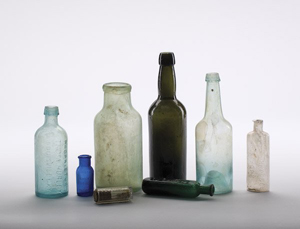
It was the one activity his failing health allowed him.
After his death, the family began cleaning out a garage where he stored a variety of items. That’s where Cheryl Leatherwood came across his collection of glass bottles – cobalt blue milk of magnesia bottles, old Dr. Pepper and Nehi drink bottles and a Five Points Soda bottle from Clio, Ala. Instead of throwing them out, Leatherwood decided to use the bottles for a special piece of garden art – a bottle tree.
“He would love it,” she said. “My daddy was raised a tenant farmer’s son, so this kind of folk art was right up his alley.”
Bottle trees, referred to by some as “haint” trees, have evolved into art for Southern gardens but have a history that may go back as far as glass
itself.
History and bottle tree buffs believe the use of bottle trees may have come out of Africa or even ancient Arabia (think, genie in a bottle). People
would place the bottle trees outside the entrance of their homes to trap evil spirits. The most common thought is the spirits could not resist the
lure of the bottles as the sun shone through them.
The spirits would enter the bottles and become trapped. Blue bottles were believed to be the most powerful in trapping the spirits. And if you’ve ever heard the eerie howl of wind blowing over an open bottle, you might understand why someone would think such a tree trapped spirits.
The idea of bottle trees spread to Europe and eventually to North America by way of African slaves.
Bottle trees are simple creations in their most basic sense. A tree – often a crepe myrtle – is stripped of foliage and most of its branches. Bottles
are slipped over what branches remain with their necks facing the tree’s trunk.
Today, people use a variety of colored bottles – green, red, blue, brown – and even clear bottles. As an alternative to an actual tree some people use a piece of wood with long nails driven into it or simply drive metal rods into the ground around an old stump. But there are a number of online companies that provide the base of a bottle tree welded from metal rods.
They’ll even sell you the bottles if you don’t have your own.
Leatherwood wanted something different. She wanted something that flowed, so she turned to artist Ronald Godwin of Brundidge, Ala. It was only the second request Godwin has ever had for a bottle tree.
Godwin said he tried to design the bottle tree with the placement of the bottles in mind and how they will accent the metal sculpture.
“I don’t do anything that looks traditional,” Godwin said.
His creation became a tribute to Leatherwood’s father. Metal rods twist to form the shape of a hummingbird.
It was a perfect fit, Leatherwood said.
The bottles and the metal itself shine in the sun.
“It is glorious in the sunlight the way it reflects off the polished metal,” Leatherwood said. “… I love the idea of something being in Southern culture and heritage and bringing it to today and bringing it with an artistic touch.”
___
Information from: The Dothan Eagle, http://www.dothaneagle.com
Copyright 2009 Associated Press. All rights reserved. This material may not be published, broadcast, rewritten or redistributed.
AP-CS-11-01-09 1312EST

